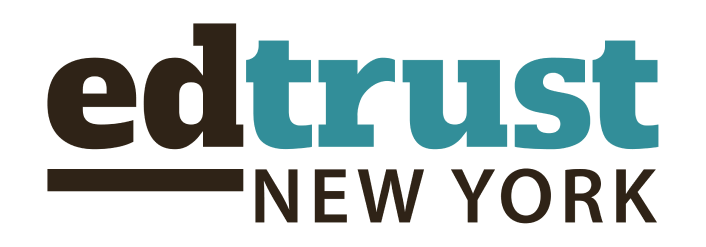Colleagues at The EdTrust recently released a series of resources highlighting strategies to ensure districts center equity and sustainability as federal Elementary and Secondary School Emergency Relief (ESSER) spending comes to a rapid halt next September. The resources share important implications for New York State leaders school districts.
As noted in The Time for Urgency, a November 2022 report about ESSER spending from the New York Equity Coalition, New York continues to trail other states in:
- Pace of spending: As of August 2023, New York had used only 34.9% of its $9 billion in American Rescue Plan Act (ARPA) funding — ranking 47th in state progress toward spending its total ESSER allocation (spending 49.5%).
- Public transparency: While more than half of U.S. states provide a public dashboard for monitoring ESSER spending, New York is an exception in not offering one. The Empire State is also one of only 14 states that has not made district-level spending information publicly available.
- State leadership: State leaders focus on funding compliance and have an opportunity to elevate best practices and evaluation tools that can help districts make impactful and sustainable investments to successfully address persistent educational inequities.
Students who receive high-quality instruction, holistic social-emotional support, and high-impact services – both in and outside of school – are more successful in postsecondary opportunities. Additional federal funding provided by the American Rescue Plan Act and recent increases in Foundation Aid from the State have the potential to accelerate post-pandemic progress. New York has a unique opportunity to be responsive to data that shows students require more support in math, literacy, and social-emotional learning and can leverage these investments to do more to ensure that all graduates are prepared for college or career. Transparency regarding how relief funds are used helps to measure impact and name the value generated by the investments. Current communications and transparency make it difficult for stakeholders to see which ESSER-funded programs are impactful and should be scaled or sustained.
As the spending deadline approaches, state and local leaders must control the narrative regarding the use of these essential dollars. When school districts can demonstrate how $9 billion in new funding positively affects student well-being and academic achievement, it generates a stronger motivation for additional investment and helps alleviate skepticism about new public investments among policymakers, advocates, parents, and other essential stakeholders. When stakeholders ask what has changed, ideally, districts and state leaders should be able to share the impact of the additional fiscal resources on student academic and social-emotional learning (SEL) outcomes. Collective understandings about the impact of new fiscal resources support future investments in the sustainability of promising initiatives and practices as ESSER funds expire.
Looking Around
New York can look to other states and districts for strategies to effectively utilize and evaluate the impact of the historic increase in funding. Nationwide, ESSER funds have been distributed to various initiatives, which include but are not limited to targeted efforts to improve student outcomes in math and literacy, postsecondary transitions, the diversification and retention of a strong educator workforce, and investments in professional learning opportunities for teachers and leaders.
Ideas from around the country:
Literacy and Mathematics Target Support:
- Three years of salary and benefits in Maryland for teachers to build their knowledge base in areas of early childhood education and reading.
- Summer Reading Camps in Alabama for lower-performing readers.
- Math Acceleration Academies in Massachusetts during winter and spring breaks.
High-Impact Tutoring, Afterschool, and Summer Programming:
- High-impact tutoring in Colorado occurring during the school day.
- High-quality afterschool and summer enrichment programs in Connecticut.
- Mentorship and development opportunities in rural areas of Georgia through community, family, and youth services programs.
College-Readiness and Dual Enrollment:
- Summer Bridge programs in Kentucky designed to prepare students for a successful transition between high school and college.
- Dual enrollment opportunities for 22,000 students in partnership with the City University of New York (CUNY) through the College Now program.
Looking Forward
New York students deserve intentional and deliberate attention to the use of relief funds to accelerate their growth toward college and career preparedness. It is not too late for state and local leaders to take meaningful action ahead of the impending fiscal cliff. As outlined in The EdTrust’s report Watch Out for the Fiscal Cliff: Advocating for Education Equity as ESSER Spending Winds Down and our 2022 report The Time for Urgency, New York leaders and advocates should work to:
1. Use existing state and local data to identify and share bright spots in academic improvement and evidence-based instructional practices, including the use of high-quality curricula and aligned professional learning to support student growth. Offer celebrations for districts using dollars to catalyze change.
2. Engage community-based organizations, parents, school leaders, and advocacy organizations to encourage directing ESSER funds toward cultivating school-community partnerships with programming both during and beyond the school day to address academic and social-emotional challenges.
3. Urge districts to invest funds in literacy and mathematics progress monitoring, with a focus on third grade reading and eighth grade math performance and use this data to inform school, district, and state instructional and policy decisions.
4. Address growing student needs around mental health, chronic absenteeism, and academic support exacerbated by pandemic learning loss, inequitable technology access, and food insecurity.
5. Encourage districts to incorporate participatory community budget processes, increase translation services and materials, and/or hire family engagement specialists tasked with supporting school environment growth, and monitoring attendance.
There is still time for state and district leaders to thoughtfully invest in and adopt these strategies that can catalyze and accelerate the impact of remaining ESSER funds.

